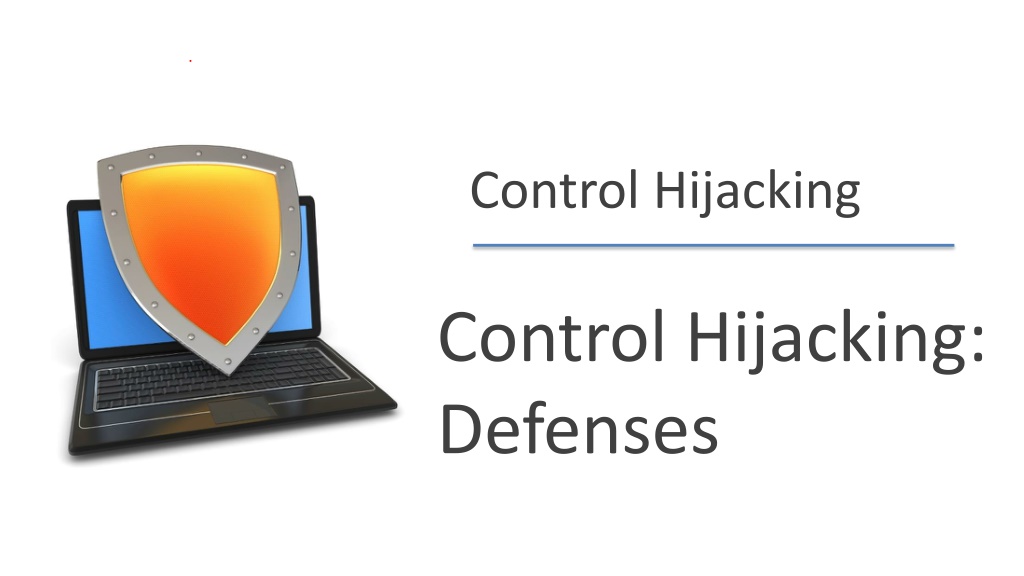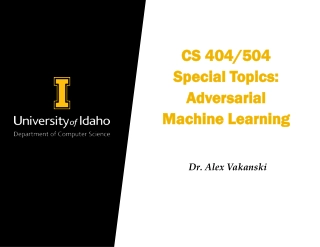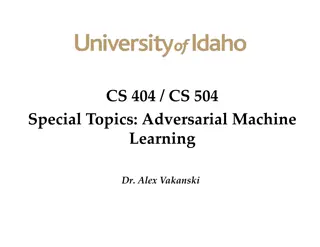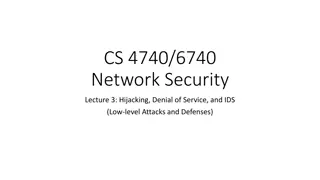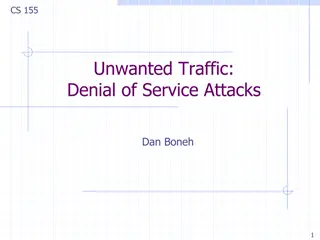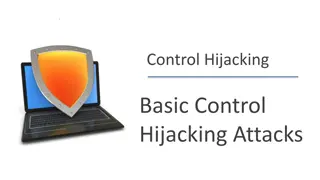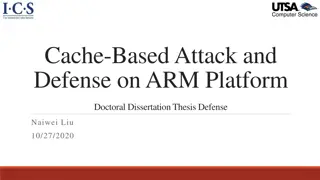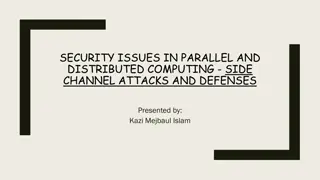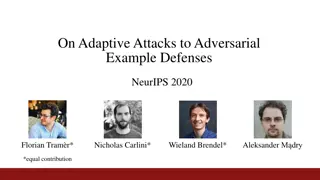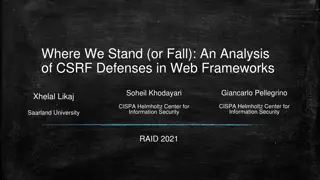Understanding Control Hijacking Attacks and Defenses
Control hijacking attacks pose a significant threat by allowing malicious actors to manipulate data and control flow within a system. This article explores common attack methods like stack smashing and heap spraying, along with defenses such as fixing bugs, implementing platform defenses, and marking memory as non-executable. Insights from Dan Boneh shed light on the importance of preventing these attacks to ensure system security.
Download Presentation

Please find below an Image/Link to download the presentation.
The content on the website is provided AS IS for your information and personal use only. It may not be sold, licensed, or shared on other websites without obtaining consent from the author. Download presentation by click this link. If you encounter any issues during the download, it is possible that the publisher has removed the file from their server.
E N D
Presentation Transcript
Control Hijacking Control Hijacking: Defenses Dan Boneh
Recap: control hijacking attacks Stack smashing: overwrite return address or function pointer Heap spraying: reliably exploit a heap overflow Use after free: attacker writes to freed control structure, which then gets used by victim program Integer overflows Format string vulnerabilities Dan Boneh
The mistake: mixing data and control An ancient design flaw: enables anyone to inject control signals 1971: AT&T learns never to mix control and data Dan Boneh
Control hijacking attacks The problem: mixing data with control flow in memory local variables ret addr SFP arguments stack frame data overwrites return address Later we will see that mixing data and code is also the reason for XSS: a common web vulnerability Dan Boneh
Preventing hijacking attacks 1. Fix bugs: Audit software Automated tools: Coverity, Prefast/Prefix. Rewrite software in a type safe languange (Java, ML) Difficult for existing (legacy) code 2. Platform defenses: prevent attack code execution Transform: Complete Breach Add runtime code to detect overflows exploits Halt process when overflow exploit detected StackGuard, CFI, LibSafe, 3. Denial of service Dan Boneh
Control Hijacking Platform Defenses Dan Boneh
Marking memory as non-execute (DEP) Prevent attack code execution by marking stack and heap as non-executable NX-bit on AMD Athlon 64, XD-bit on Intel P4 Prescott NX bit in every Page Table Entry (PTE) Deployment: Linux (via PaX project); OpenBSD Windows: since XP SP2 (DEP) Visual Studio: /NXCompat[:NO] Limitations: Some apps need executable heap (e.g. JITs). Can be easily bypassed using Return Oriented Programming (ROP) Dan Boneh
Examples: DEP controls in Windows DEP terminating a program Dan Boneh
Attack: Return Oriented Programming (ROP) Control hijacking without injecting code: stack libc.so args ret-addr sfp exec() printf() local buf /bin/sh Dan Boneh
ROP: in more detail To run /bin/sh we must direct stdin and stdout to the socket: dup2(s, 0) dup2(s, 1) execve("/bin/sh", 0, 0); // map stdin to socket // map stdout to socket execve("/bin/sh") ret dup2(s, 0) ret dup2(s, 1) ret Gadgets in victim code: Stack (set by attacker): overflow-str 0x408400 0x408500 0x408300 ret-addr Stack pointer moves up on pop Dan Boneh
ROP: in even more detail dup2(s,0) implemented as a sequence of gadgets in victim code: 0x408400 0x408100 0x408300 0x408200 5e c3 pop rdi ret pop rsi ret pop rax ret syscall ret 5f c3 Stack (by attacker): overflow-str 0x408100 s 0x408200 0 0x408300 33 0x408400 ret-addr (rdi s) (rax 33) syscall #33 (rsi 0) Dan Boneh
What to do?? Randomization ASLR: (Address Space Layout Randomization) Map shared libraries to rand location in process memory Attacker cannot jump directly to exec function Deployment: (/DynamicBase) Windows7: 8 bits of randomness for DLLs aligned to 64K page in a 16MB region 256 choices Windows 8: 24 bits of randomness on 64-bit processors Other randomization methods: Sys-call randomization: randomize sys-call id s Instruction Set Randomization (ISR) Dan Boneh
ASLR Example Booting twice loads libraries into different locations: Note: everything in process memory must be randomized stack, heap, shared libs, base image Win 8 Force ASLR: ensures all loaded modules use ASLR Dan Boneh
A very different idea: kBouncer kBouncer pop rdi ret pop rsi ret pop rax ret syscall ret kernel Observation: abnormal execution sequence ret returns to an address that does not follow a call Idea: before a syscall, check that every prior ret is not abnormal How: use Intel s Last Branch Recording (LBR) Dan Boneh
A very different idea: kBouncer kBouncer pop rdi ret pop rsi ret pop rax ret syscall ret kernel Inte sLast Branch Recording (LBR): store 16 last executed branches in a set of on-chip registers (MSR) read using rdmsr instruction from privileged mode kBouncer: before entering kernel, verify that last 16 rets are normal Requires no app. code changes, and minimal overhead Limitations: attacker can ensure 16 calls prior to syscall are valid Dan Boneh
Control Hijacking Defenses Hardening the executable Dan Boneh
Run time checking: StackGuard Many run-time checking techniques we only discuss methods relevant to overflow protection Solution 1: StackGuard Run time tests for stack integrity. Embed canaries in stack frames and verify their integrity prior to function return. Frame 1 Frame 2 top of stack sfp ret str sfp ret str local canary local canary Dan Boneh
Canary Types Random canary: Random string chosen at program startup. Insert canary string into every stack frame. Verify canary before returning from function. Exit program if canary changed. Turns potential exploit into DoS. To corrupt, attacker must learn current random string. Terminator canary: Canary = {0, newline, linefeed, EOF} String functions will not copy beyond terminator. Attacker cannot use string functions to corrupt stack. Dan Boneh
StackGuard (Cont.) StackGuard implemented as a GCC patch Program must be recompiled Minimal performance effects: 8% for Apache Note: Canaries do not provide full protection Some stack smashing attacks leave canaries unchanged Heap protection: PointGuard Protects function pointers and setjmp buffers by encrypting them: e.g. XOR with random cookie Less effective, more noticeable performance effects Dan Boneh
StackGuard enhancements: ProPolice ProPolice (IBM) - gcc 3.4.1. (-fstack-protector) Rearrange stack layout to prevent ptr overflow. args ret addr String Growth Protects pointer args and local pointers from a buffer overflow SFP CANARY local string buffers Stack Growth pointers, but no arrays local non-buffer variables copy of pointer args Dan Boneh
MS Visual Studio /GS [since 2003] Compiler /GS option: Combination of ProPolice and Random canary. If cookie mismatch, default behavior is to call _exit(3) Function prolog: sub esp, 8 // allocate 8 bytes for cookie mov eax, DWORD PTR ___security_cookie xor eax, esp // xor cookie with current esp mov DWORD PTR [esp+8], eax // save in stack Function epilog: mov ecx, DWORD PTR [esp+8] xor ecx, esp call @__security_check_cookie@4 add esp, 8 Enhanced /GS in Visual Studio 2010: /GS protection added to all functions, unless can be proven unnecessary Dan Boneh
/GS stack frame args String Growth ret addr Canary protects ret-addr and exception handler frame SFP exception handlers CANARY local string buffers Stack Growth pointers, but no arrays local non-buffer variables copy of pointer args Dan Boneh
Evading /GS with exception handlers When exception is thrown, dispatcher walks up exception list until handler is found (else use default handler) After overflow: handler points to attacker s code exception triggered control hijack Main point: exception is triggered before canary is checked 0xffffffff SEH frame SEH frame high mem ptr to next handler buf next next handler attack code next handler Dan Boneh
Defenses: SAFESEH and SEHOP /SAFESEH: linker flag Linker produces a binary with a table of safe exception handlers System will not jump to exception handler not on list /SEHOP: platform defense (since win vista SP1) Observation: SEH attacks typically corrupt the next entry in SEH list. SEHOP: add a dummy record at top of SEH list When exception occurs, dispatcher walks up list and verifies dummy record is there. If not, terminates process. Dan Boneh
Summary: Canaries are not full proof Canaries are an important defense tool, but do not prevent all control hijacking attacks: Heap-based attacks still possible Integer overflow attacks still possible /GS by itself does not prevent Exception Handling attacks (also need SAFESEH and SEHOP) Dan Boneh
Even worse: canary extraction A common design for crash recovery: When process crashes, restart automatically (for availability) Often canary is unchanged (reason: relaunch using fork) local buffer ret addr C A N A R Y A crash Danger: canary extraction byte by byte ret addr local buffer C A N A R Y B crash ret addr local buffer C A N A R Y C No crash local buffer ret addr No crash C A N A R Y C A Dan Boneh
Similarly: extract ASLR randomness A common design for crash recovery: When process crashes, restart automatically (for availability) Often canary is unchanged (reason: relaunch using fork) local buffer ret addr Danger: Extract ret-addr to de-randomize stack location C A N A R Y A crash ret addr local buffer C A N A R Y B crash ret addr local buffer C A N A R Y C No crash Extract stack function pointers to de-randomize heap local buffer ret addr No crash C A N A R Y C A Dan Boneh
What if cant recompile: Libsafe Solution 2: Libsafe (Avaya Labs) Dynamically loaded library (no need to recompile app.) Intercepts calls to strcpy (dest, src) Validates sufficient space in current stack frame: |frame-pointer dest| > strlen(src) If so, does strcpy. Otherwise, terminates application top of stack src buf sfp ret-addr sfp ret-addr dest Libsafe strcpy main Dan Boneh
More methods StackShield At function prologue, copy return address RET and SFP to safe location (beginning of data segment) Upon return, check that RET and SFP is equal to copy. Implemented as assembler file processor (GCC) Control Flow Integrity (CFI) A combination of static and dynamic checking Statically determine program control flow Dynamically enforce control flow integrity Dan Boneh
Control flow integrity (CFI) [ABEL05, ] Ultimate Goal: ensure control flows as specified by code s flow graph void HandshakeHandler(Session *s, char *pkt) { ... s->hdlr(s, pkt) } Compile time: build list of possible call targets Run time: before call, check validity of s->hdlr Lots of academic research on CFI systems: CCFIR (2013),kBouncer (2013), FECFI (2014), CSCFI (2015), and many attacks Dan Boneh
Control Flow Guard (CFG) (Windows 10) Poor man s version of CFI: Protects indirect calls by checking against a bitmask of all valid function entry points in executable ensures target is the entry point of a function Dan Boneh
Control Flow Guard (CFG) (Windows 10) Poor man s version of CFI: Protects indirect calls by checking against a bitmask of all valid function entry points in executable a jump to a valid wrong function Does not prevent attacker from causing Hard to build accurate control flow graph statically ensures target is the entry point of a function Dan Boneh
An example void HandshakeHandler(Session *s, char *pkt) { s->hdlr = &LoginHandler; ... Buffer overflow in Session struct ... } Attacker controls handler void LoginHandler(Session *s, char *pkt) { bool auth = CheckCredentials(pkt); s->dhandler = &DataHandler; } Static CFI: attacker can call DataHandler to bypass authentication void DataHandler(Session *s, char *pkt); Dan Boneh
Cryptographic Control Flow Integrity (CCFI) Threat model: attacker can read/write anywhere in memory, program should not deviate from its control flow graph CCFI approach: Every time a jump address is written/copied anywhere in memory: compute 64-bit AES-MAC and append to address tag = AES(k, (jump-address, 0 ll source-address) ) On heap: tag = AES(k, (jump-address, 1 ll stack-frame) ) on stack: Before following address, verify MAC and crash if invalid Where to store key k? In xmm registers (not memory) Dan Boneh
Back to the example void HandshakeHandler(Session *s, char *pkt) { s->hdlr = &LoginHandler; ... Buffer overflow in Session struct ... } Attacker controls handler void LoginHandler(Session *s, char *pkt) { bool auth = CheckCredentials(pkt); s->dhandler = &DataHandler; } CCFI: Attacker cannot create a valid MAC for DataHandler address void DataHandler(Session *s, char *pkt); Dan Boneh
THE END Dan Boneh
